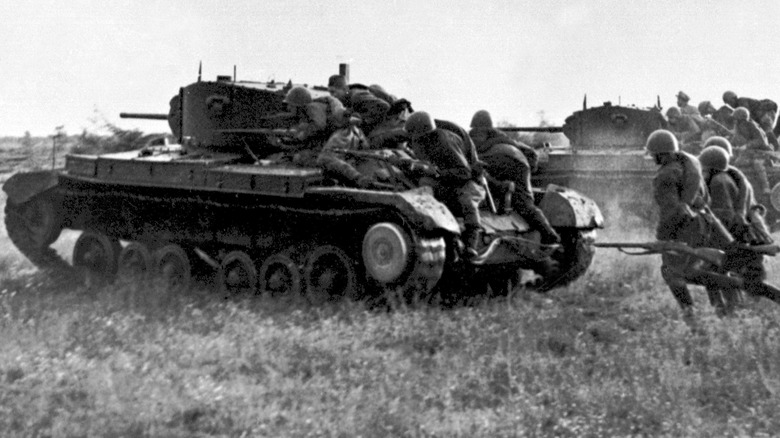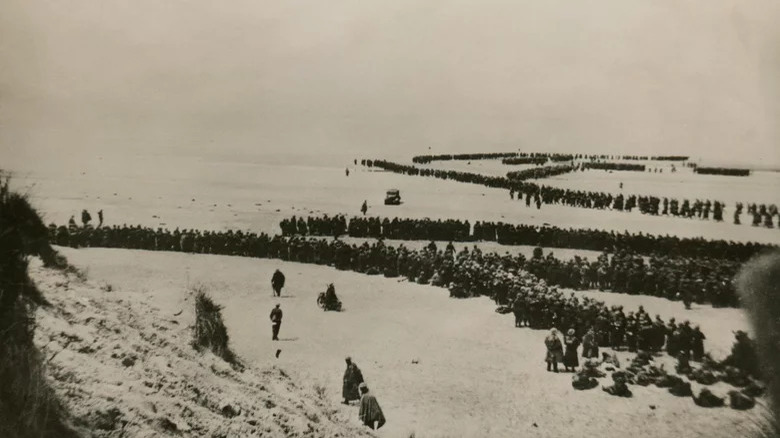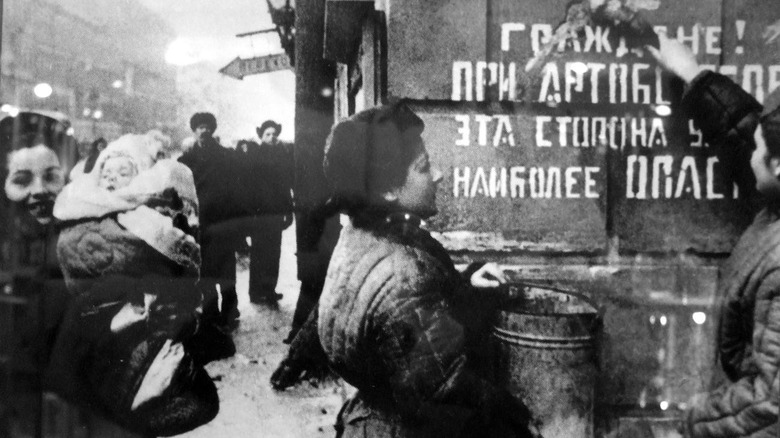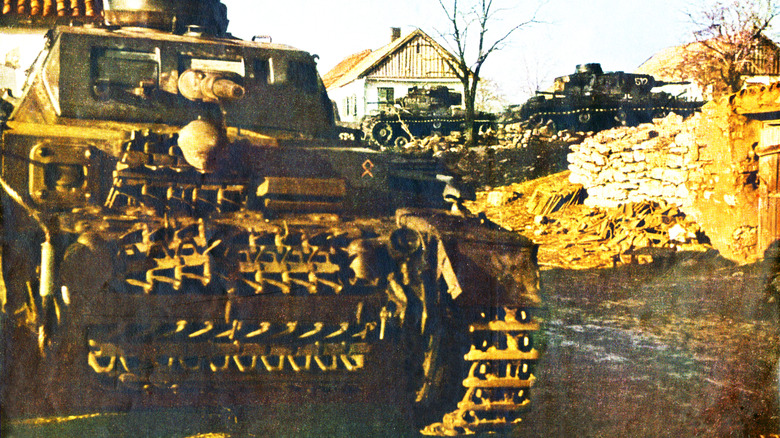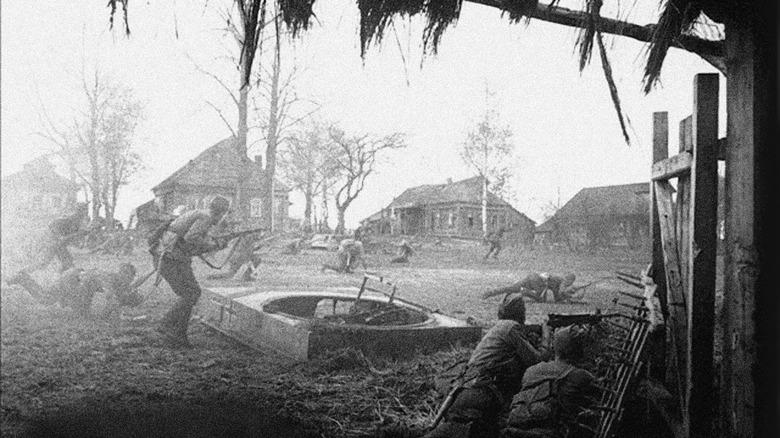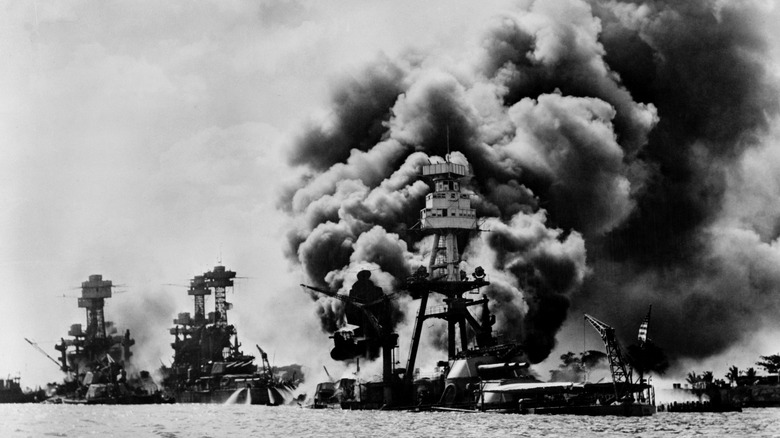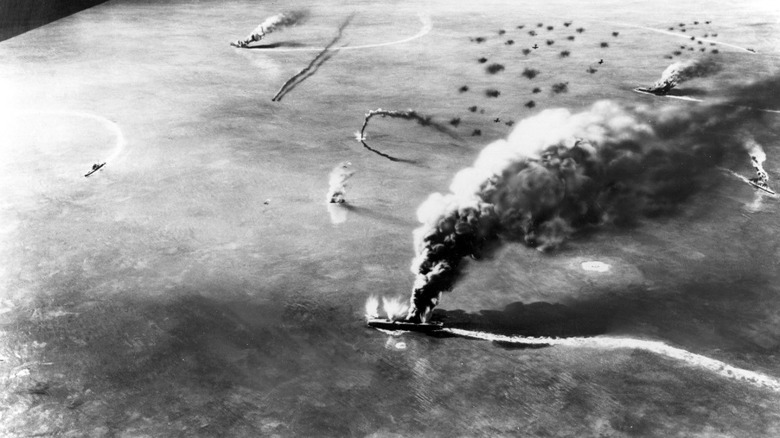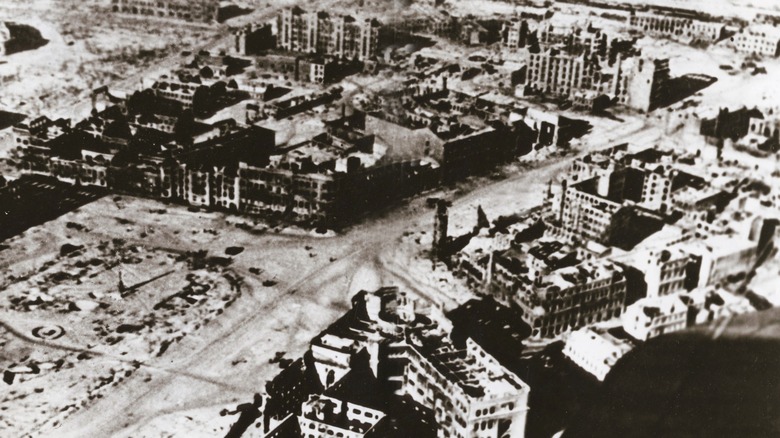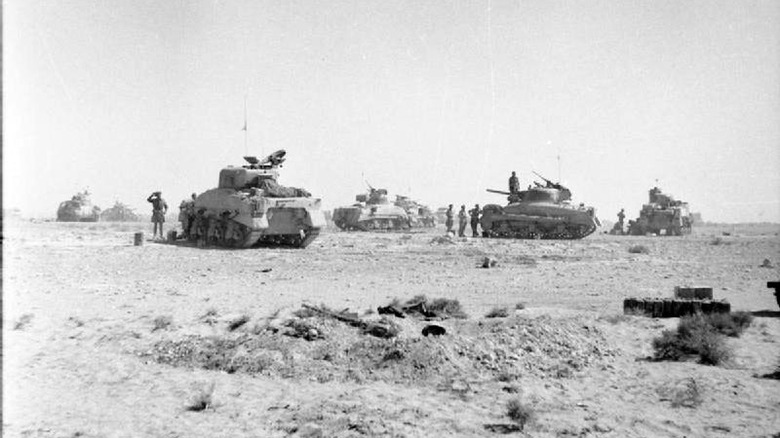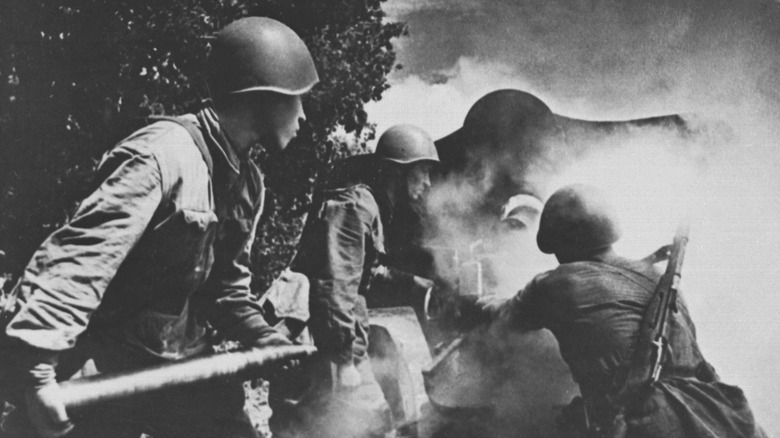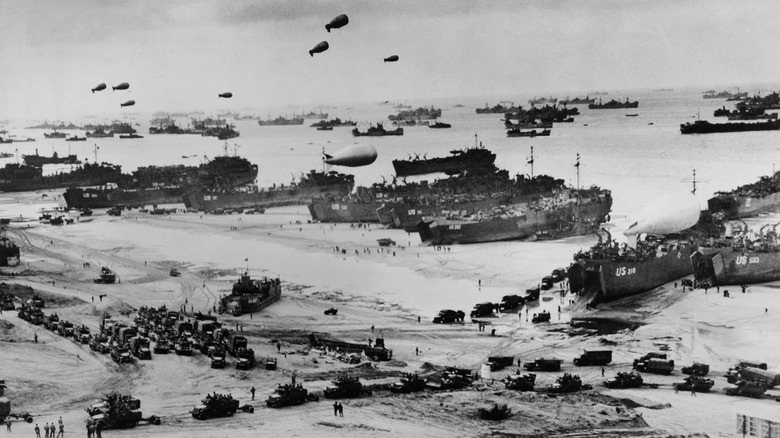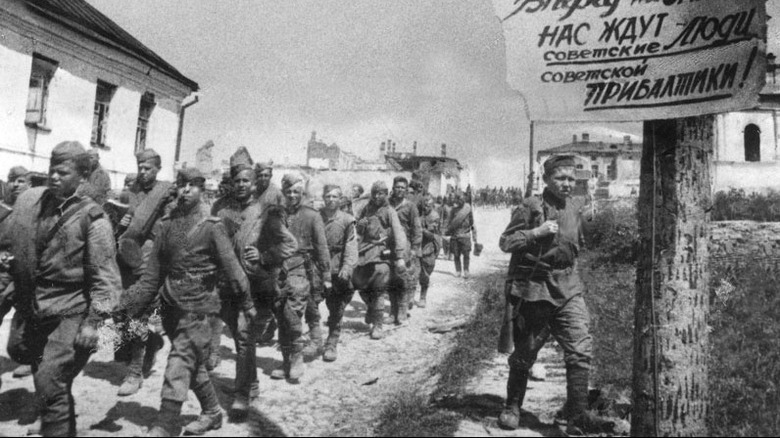Most Important Battles Of World War II
World War II was the largest, deadliest, and most widespread armed conflict in human history, notes History. It was fought in almost every type of environment imaginable: on and under the sea, in the skies, in hills, mountains, open fields, cities, deserts, forests, and frozen wastelands. Some of the battles were quick, bloodless skirmishes. Others were mighty deathmatches that lasted months if not years, consuming the lives of hundreds of thousands or even millions of souls, military and civilian alike. In almost every theater, the conflict was defined by an initial period of violent Axis expansion, then a turning point, followed by a final Allied advance.
So which campaigns and battles turned the tide? Which ones captured the attention of the world and the imaginations of millions in their aftermath? Here's a list of some of the war's largest, most tragic, most epic, deadliest, and most all-around important battles.
Battle of France
History says that the Entente victory in World War I resulted in harsh terms for a defeated Germany, via the Treaty of Versailles. When he rose to power, Adolf Hitler vowed to pay back the French and British for Germany's humiliation. He got his chance in Spring 1940.
The Allies placed their hopes in the Maginot line, which History says was 280 miles long and contained a huge number of pillboxes, minefields, and gun batteries. But the Germans had no intention of engaging the line directly, choosing instead to go around it by sending Panzers through the Ardennes forest, which the Allies believed too dense for tanks. By the time they realized what was happening, it was too late: German troops dashed for the English Channel, cutting off the Belgian and British armies, and half the French. The British were barely evacuated from Dunkirk while German troops poured into northern France. By the time they reached Paris, the whole country was collapsing.
English Heritage says that Germany's six-week conquest of France stunned both sides and the world at large, ended large-scale combat in the west until D-Day four years later, and handed all of France and her territories to German control. It was Hitler's greatest victory.
Siege of Leningrad
Britannica notes that, following Nazi Germany's June 1941 invasion of the Soviet Union, its armies were mobilized just a few months later towards Leningrad, with support from their Finnish allies, both groups enclosing the city from west, south, and north. To counteract the enemy approach, Leningrad's citizens organized antitank fortifications and some 200,000 able-bodied men to defend their city.
It would be enough to hold the city, but not to prevent its suffering. By November, the Axis had effectively encircled the city, severing supply lines and thus cutting off the city's food supply. The anguish of mass hunger set in quickly. In 1942 alone, Britannica notes that an astonishing, heart-wrenching 650,000 people in the city had lost their lives, mostly due to starvation. World at War Magazine describes the Road of Life — Russian supply trucks making a perilous journey across the frozen surface of Lake Ladoga to reach the city — as the city's only lifeline.
The following year, the Red Army managed to pierce the German lines just south of Lake Ladoga, allowing precious supplies to enter the city overland for the first time in over a year. And by early 1944, History notes the Soviets had amassed enough force to drive the Germans from the outskirts of town, lifting the siege. It wasn't the most decisive battle of the war, but after nearly 900 days and 800,000 deaths, it's certainly one of the most epic, and tragic.
Operation Barbarossa
Drunk on victory in the west, Adolf Hitler turned his attention — and his Wehrmacht — to his ultimate ideological objective in June 1941: the conquest of the Soviet Union. Whereas the Nazis saw their western foes as misguided racial brethren, they saw the peoples to the east as race-mixed Slavic hordes who, under sinister Jewish domination, carried and spread the disease of communism. The BBC notes that Nazis hoped to remove these racial and ideological threats to the Reich through genocide and seize great swaths of resource-rich land for ethnic Germans to agriculturally resettle as lebensraum (living space).
Operation Barbarossa was launched on June 22, 1941 (via Britannica). For months, the titanic, 3-million man Axis invasion force smashed aside all resistance in its crusade against Jewish communism, as per History. The Red Army tank and air arms were decimated. Industry was evacuated to the east. Great battles of encirclement around Minsk, Smolensk, Kiev, and elsewhere, led to the complete destruction of entire Soviet armies, while civilians in newly occupied territories got their first taste of the monstrous genocidal cruelty that characterized Nazi rule.
Still, despite promising early gains, the Germans had by the end of the year failed to capture Leningrad, Sevastopol, or Moscow, and fell well short of their original goal of knocking the USSR out of the fight in a single strike, notes History. While they still had the upper hand, they were now trapped in a war of attrition in the east for which they were ill prepared.
Battle of Moscow
In late 1941, the initially rapid Axis advance into Russia had been delayed due to the fall rasputitsa, or "time without roads," when autumn rains turned Russia's primitive dirt road network into an ocean of mud, making large scale maneuvers impossible, writes Richard Overy in "Russia's War." But plummeting temperatures froze the ground solid, and soon Operation Typhoon was a go, as per History: German armies were now converging on the Soviet capital of Moscow.
To offset the rising panic, the National WWII Museum notes that Joseph Stalin stayed in the city, held a military parade there, and put its people to work. As all men of fighting age were deploying for war, the task of building the city's defensive rings fell to the women and children. Stalin also summoned Field Marshal Georgy Zhukov to oversee Moscow's defense. Zhukov noted that after the battles of Bryansnk and Vyazma, few troops remained to man the new positions (via the History Learning Site). Hard decisions had to be made, but the Russians managed to assemble new armies in the nick of time.
When the Germans arrived, a combination of frigid temperatures, supply lines stretched beyond breaking point, and especially fanatical resistance from Soviet troops more adept at winter combat, halted their attack. Then the Red Army launched its own offensive and threw them back (via the History Learning Site). The Germans weren't close to defeat, but they weren't close to victory, either.
Pearl Harbor
The National World War II Museum notes that Americans were divided over whether or not the U.S. should be involved in the war prior to Pearl Harbor in 1941. The article goes on to note that many in the U.S., which hadn't yet been attacked by either Japan or the European Axis powers, felt the country should stay out of other nation's affairs. That all changed on December 7, 1941.
What President Franklin Roosevelt called "a date which will live in infamy" started like any other. But by 8 a.m., the skies over Honolulu's Pearl Harbor, where the U.S. Pacific fleet was stationed, according to History, were blackened by incoming Japanese bombers. As History notes, Japan had been inching towards war with the Americans for months, ever since the U.S. cut off vital supplies to the empire in response to its war in China.
Still, the attack took the Americans by complete surprise. Britannica notes that 180 American planes were destroyed on the ground, eight battleships were seriously damaged (two beyond repair), and more than 2,300 lives were lost. Britannica goes on to say, however, that the bulk of the U.S. carrier fleet was not present and thus escaped the worst of it. It would play a mighty role in the months to come.
Battle of Midway
The National WWII Museum notes that the Japanese hoped to deal the U.S. Pacific fleet a crippling blow at Pearl Harbor. But several U.S. aircraft carriers had survived, says History. To finish them off, Admiral Isoroku Yamamoto decided to lure them into battle by attacking Midway atoll, near Hawaii (via the National Park Service). But U.S. intelligence caught wind of the plans and dispatched three carriers in secret. The Americans, itching for vengeance, were preparing a trap of their own.
The battle began on June 4, 1942, roughly six months after the attack on Pearl Harbor. Japanese aircraft bombed Midway island itself, taking out some land-based American planes and anti-aircraft defenses. But the bulk of the three day fight was at sea, according to History, as carrier-based planes on both sides scoured the ocean for the enemy fleet.
The Americans spotted the Japanese first. Several sorties of bombers, dispatched to knock out Japanese carriers, were shot down before achieving any notable success. But then, in a stroke of astonishing luck, U.S. torpedo-bombers and dive-bombers appeared over the Japanese fleet while its defensive aircraft were on deck, refueling. Defenseless, the Japanese lost all four of its heavy carriers while only knocking out a single American counterpart: the Yorktown.
Japan's industrial inferiority meant this total, devastating loss instantly and permanently turned the tide of war in favor of the Americans (via Britannica), and set the empire on a path to decline in the Pacific.
Battle of Stalingrad
The battle for Stalingrad remains the largest and deadliest in history, according to History, and the most significant turning point in the war against Adolf Hitler's Germany. Millions fought in the meat grinder on the Volga, and as many as 2 million became casualties.
The city was initially a minor objective. It was simply in the path of the Germans, who were tasked with advancing to the Volga to preemptively block a possible Soviet counterattack against Axis oil-gathering operations in the Caucasus, as per the Daily Chronicles of World War II. But once the fighting began, it became the focus of both sides. Reinforcements flooded in, and soon the entire ruined city became consumed in a maelstrom of chaos and death. Then, just when the Germans seemed close to crushing the remainder of Red Army resistance in the city, the Russians launched Operation Uranus and surrounded them, according to Britannica, before defeating every Axis attempt to rescue and resupply the encircled men. The Wehrmacht froze and starved for months before laying down their arms in February 1943. By then, all German gains made in the previous summer's offensive, which had brought them to the gates of the city, had been reversed.
For the Nazis, it was a catastrophe: Vast forces were withdrawn from the west to shore up the collapsing front in Russia. But it was not enough, notes The History Reader. The tide had turned.
Second Battle of El Alamein
Britain struggled in ground combat against the German Wehrmacht in the beginning of the war. Britannica notes they'd been thrown into the sea during the Nazi conquest of France. They got their next chance to fight on land in the North African campaign, but after some victories against the Italians, German Gen. Erwin Rommel arrived with his Afrika Korps and dominated them for years, according to the Atlantic, pushing them back into Egypt by summer 1942. By October, British Eighth Army Cmdr. Bernard Montgomery was under enormous pressure from London to defeat the Germans, eliminate the Axis threat to the Suez Canal, and deliver a desperately needed win to boost morale back home.
Luckily, he was up to the task. The British National Army Museum notes that Montgomery amassed a force of 190,000 men and over 1,000 tanks to Rommel's 116,000 men and barely half as many panzers. The museum goes on to say that the British used their superiority to first penetrate German defenses, before engaging them in a close-quarters battle of attrition to wear them down. When they launched Operation Supercharge in the beginning of November, the Germans were too exhausted to resist.
The battle broke the Axis winning streak against the Western Allies, threw the Germans into retreat, and was the beginning of the end of the African campaign (via the BBC). The next Allied target: Europe itself.
Battle of Kursk
The tide of war turned against Germany in November 1942, thanks to defeats at the hands of the Allies in Africa, and, crucially, the Soviets at Stalingrad (via Britannica). By spring 1943, Germany was retreating everywhere, and Adolf Hitler's prestige at home and with his allies was badly mauled. A major victory in Russia was needed to stabilize the crumbling situation. The German high command drew up plans for Operation Citadel, as per War History Online: a tank-heavy assault that they hoped would pinch out the Kursk salient and restore the initiative to the Axis.
But Soviet and British intelligence caught wind of their plans. Joseph Stalin was persuaded by his high command to receive the German attack on prepared defenses before launching counterstrikes, says Military Times. The Soviets turned the northern and southern necks of the Kursk bulge into the most heavily defended area in the history of warfare, bristling with guns, trenches, minefields, anti-tank ditches, artillery hardpoints, and vast reserves of fighting men.
The Red Army stopped Germany's final eastern blitzkrieg cold in the largest tank battle of all time, according to Military Times. Then they launched their own attacks, according to History, and threw the enemy out of Russia for good. They would be on the defensive for the rest of the war.
Invasion of Normandy
By mid 1944, the Western Allies had inflicted considerable losses on the German army, but their contributions paled in comparison to those of the Soviet Union, which had done the bulk of the fighting and dying since their nation was invaded. A second front of major ground combat operations was overdue, and after the invasion of Italy failed to bring about a swift advance into Europe's "soft belly," a cross-channel, Western Allied invasion of Nazi occupied France was agreed upon, as per History Today.
As per Britannica, Operation Overlord was a titanic international effort made possible by extensive deception operations, massive logistical groundwork, and the training of new legions of Anglo-American forces who would be called upon to crack Adolf Hitler's Atlantic wall. On June 6, airborne troops landed behind enemy lines to seize key bridges and crossroads just hours before thousands of Allied soldiers stormed five beaches at Normandy, France, as well as other minor sites. The landing zones were in Allied hands by the end of the day, but a two-month slog through the dense hedgerows and urban centers of Normandy was in order before a true breakout was possible. Still, Allied strength was overwhelming, and when the breakout was finally achieved in early August it brought about the collapse of the German army in France.
This "Great Crusade," as Dwight Eisenhower dubbed it, known globally as D-Day, was one of western civilization's great historical triumphs, and the swan song of an already crumbling Third Reich.
Operation Bagration
Summer 1944. The war rages in Italy, and now France. Germany is facing defeat on all fronts.
The Germans expected the Soviets to launch an offensive in the Ukraine to capitalize on their recent successes there. Instead, the Stavka approved Gen. Konstantin Rokossovsky's plan, Operation Bagration (via HistoryNet): a 2.3-million man, four-front assault on the much smaller German Army Group Centre in Belorussia. Launched three years to the day after the Axis invasion of the USSR and made possible by an enormous deception campaign, Bagration was a breathtaking success. By August, 28 of Army Group Centre's 34 divisions had ceased to exist, writes the Hoover Institution. Soviet tanks reached the Baltic Sea, briefly cutting off Army Group North. The offensive also paved the way to the success of the Ukrainian attack the Germans originally feared: the Lvov-Sandomierz offensive, as per HistoryNet, which brought the Russians to the gates of Warsaw.
Not even replacing timid Ernst Busch with defensive mastermind Walter Model salvaged the situation for the Axis. In what has been described as the most calamitous defeat in German history, the Red Army broke the back of the Wehrmacht and threw open the road to Berlin, as per The Past. The days of the Third Reich were numbered.
